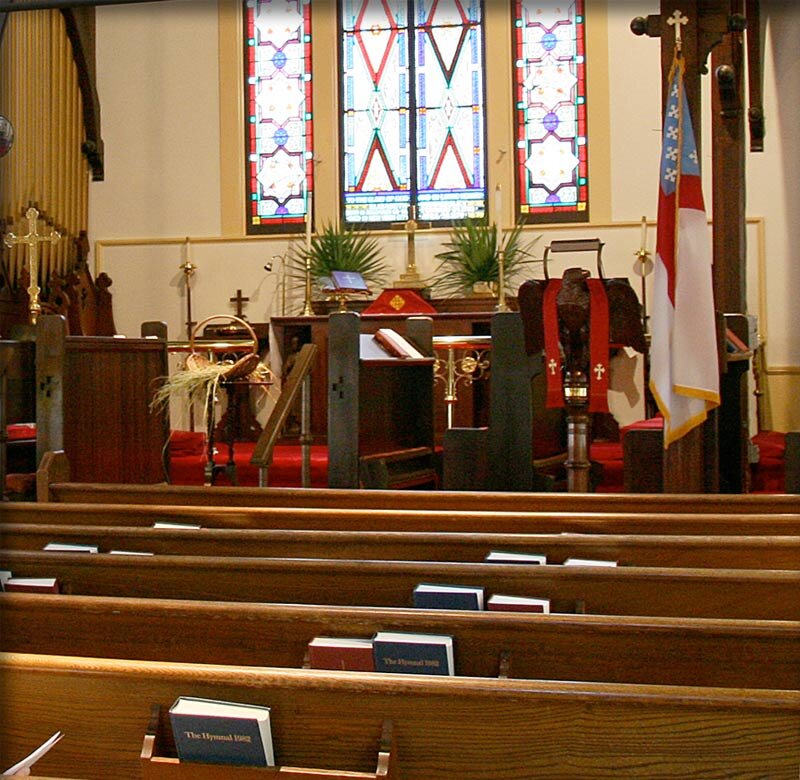Church History
The Holy Trinity Parish was established in 1880. However, with no church of their own, Episcopalians in and around Onancock had to travel to Accomac for Sunday morning services at St. James Episcopal Church, or, on alternate Sunday afternoons, to Emmanuel-Jenkins Bridge Episcopal Church in Temperanceville or to St. George's Episcopal Church in Pungoteague to attend services. In those horse and buggy days, the shortest of those trips took an hour or longer each way.
Holy Trinity Episcopal Church was conceived and construction began in 1881, when Diocesan Missioner Rev. Thomas Norwood visited the town. Rev. Norwood's casual after dinner remark that "You good folks need a little chapel" was all it took to set things in motion. Someone offered land, another lumber, a window was promised. By noon the next day, cash donations were being made. Architectural plans were drawn up at no charge, and workmen and carpenters were taken into homes board-free.
That same year, 1881, Rev. Francis M. Burch accepted a call to the Episcopal Churches of Accomack County. Holy Trinity's foundation was laid under his leadership, and when he resigned in 1883, the framework was nearly finished. The Vestry adopted a pay-as-you-go plan, so with fewer than 50 congregants, work was slow.
The Rev. John McNabb celebrated the first service in Holy Trinity on Palm Sunday, March 26, 1886. The building was heated by a coal stove and lacked carpet, chancel rail, and choir stalls, but the congregation sang "Onward Christian Soldiers" that morning with gusto and pride. The Church was consecrated in 1893 and continued to share a minister with the three other Episcopal churches until 1956 when, under Rev. Taylor Willis, Holy Trinity and Emmanuel-Jenkins Bridge separated into a two church Cure. In 1976, under the guidance of Rev. Elmer T. Henry and by unanimous vote of the Congregation, Holy Trinity became an independent church within the Diocese of Southern Virginia.
In 1886 or 1887 a steeple more than twice the height of the church was built which ran down the front of the church. However, the strong Eastern Shore winds caused enough sway in the steeple to endanger the church's structure. Consequently, it was taken down.
Over the years, Holy Trinity has expanded to meet the needs of its congregation. The Church rectory was built in 1890 and completely renovated in 2002. A Parish Hall was added to the church in 1923 and expanded in 1950. In 1960, a house on the west side of the church was purchased to provide room for the expanding Sunday School. In 1966, the Parish Hall was expanded by the addition of permanent classrooms and offices, and the house was torn down to provide much needed parking space and, in later years, a small memorial garden.
Just as its physical properties have changed and grown over the years, so has Holy Trinity itself adjusted to better serve its parishioners and the surrounding community. Several new forms of worship were introduced during the 1980's, including the Lydia prayer group, a healing ministry, and Cursillo. In addition, the Church installed its first female associate rector in 2000.
Within the larger community, Holy Trinity is a part of the Accomack Interfaith Crisis Council which, together with other area churches, seeks to help the town's neediest persons. Holy Trinity participates in a series of ecumenical Lenten services. In addition, the Parish Hall is used by several local non-profit groups. The Literacy Council has a dedicated room for tutoring sessions. AA and Al-Anon groups meet in the kitchen several times a week. Mission groups from Boston College stay in the Parish Hall twice a year while working on Habitat for Humanity Projects, as well.
In 2015, in association with Holy Trinity’s Capital Campaign, the congregation started looking at ways to become more environmentally active. At the same time the local Shorekeeper organization, now merged with the Chesapeake Bay Foundation, developed a certification program. Businesses and non –profit organizations that adopted best management practices for conserving energy, protecting water resources and communicating with the community would be awarded certificates.
Holy Trinity was able to satisfy enough of the best management practices, which included a porous surface for the parking lot, installing a rain garden to reduce runoff, and composting food waste, to achieve Shorekeeper Green Certification. These practices form the basis of a continuing effort to lower energy use, conserve resources, and work with other churches to increase environmental awareness and conservation practices.





